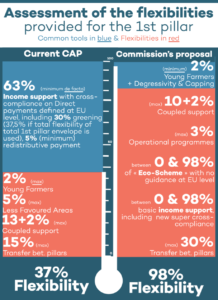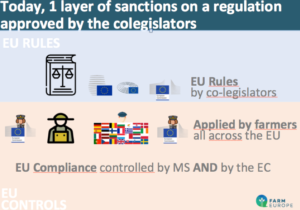6 safety-cones to secure a more efficient and truly common CAP
CAP reform
In view of the Commission’s proposal,
6 safety-cones
to secure a more efficient and truly common CAP
A CAP reform proposed by Commissioner Hogan centered on a new governance that confuses flexibilities and renationalization…
The reform proposal presented by the Commission on the 1stof June 2018 is above all a proposal for an administrative reform of the CAP. However, the proposed new implementation model would have very strong policy implications by splitting the CAP into 27 national agricultural policies (or more with regionalized agricultural policy strands), by simplifying management for Commission services but increasing the burden for the Member States without any simplification for farmers.
The Commission proposal proposes to each Member State to build its own agricultural policy by defining the eligibility rules, the requirements linked to the different measures that the CAP can fund, its control and penalty policy, as well as its levels of ambitions – essentially environmental – to reach. On this basis, the Commission would have the power to approve or reject these national policies, taking over most of the powers of the co-legislators in terms of guidance and construction of the CAP without, however, being able to withstand the will of strong governments.
While Member States would have full discretion on how to use 98% of CAP funds, two farmers with similar farms in border regions would face different economic environments and ecological requirements, whereas today the CAP establishes a common base of rules but also use of almost 2/3 of the funds of the 1st pillar of the CAP (direct aids). Agricultural markets would quickly become a battleground within the European Union to the detriment of the single market. For some, the reduction of environmental ambition would be a temptation to offer an economic advantage to their sectors.
With this proposal, the Commission says it wants to encourage the Member States when drafting their national agricultural (political) strategies to make more consistent use of the support of the first pillar of the CAP and the second pillar (rural development) and move from a ‘compliance policy’ to a ‘performance policy’ based on achievements and outcome indicators.
While these two objectives are laudable, the presented proposal however does not make it possible to achieve them: the first will be subject to the good will and priorities of various governments, the second would be to be in a position to measure both the economic and the environmental impact of the implemented measures within the framework of the CAP and not – as proposed by the Commission – to be limited to only counting the number of hectares or farmers concerned by such or such a measure without their impact being otherwise assessed in upstream.
… 6 safety-cones for a more effective and truly common PAC.
Given the societal, economic and environmental challenges to be met, the European Union needs a CAP that is strong, effective, common and adapted to the realities of a European Union rich in its diversity.
1 Put in place key parameters in basic acts at a common level: minimum level for basic income support
2 Give a European dimension to the ”Eco-Scheme”, concentrating the measures to be proposed by the Member States on the promotion of innovative tools and practices able to encourage the environmental and economic transition of European agriculture
3 Promote the economic dimension of the CAP with a minimum financial objective for risk management tools and for economic and environmental performance investments
4 Define a European reference environmental basis for the ‘super’ conditionality with the possibility for Member States and farmers to propose equivalent measures where it is more appropriate
5 Build an effective and well-financed crisis reserve with guarantees that the European Commission will react without delay in the event of serious market disruption
6 No approval process by the European Commission on the elements agreed by the co-legislators and included in the EU legal framework
In recognition of the important issue of deeply rectifying the Commission’s proposal, the Members of the Agriculture Committee of the outgoing European Parliament (Comagri) adopted a large number of amendments in order to put in place these 6 safety markers and start to give them life in the draft CAP regulations.
It will be up to the next Parliament and its elected representatives to build this efficient Common Agricultural Policy, which is the driving force behind the establishment of dual performance agriculture across the entire European territory in order so that:
- the European Union resumes its place in the ‘world concert’,
- European citizens find themselves in their agriculture and in the CAP,
- farmers find a strength of ambition and a protective environment with the European Union.
The amendments adopted by the outgoing Comagri go in the right direction. They are a first step.
The next Parliament will be responsible for deciding on the CAP that will guide the agricultural sectors for the next decade.
To put European agriculture back in a position to successfully project, the work of this Comagri will have to be deepened so that:
- the CAP can be a tool of real incentive to investments of double – environmental and economic – performance,
- and that transition to these new modes of virtuous production, notably based on digital and new technologies, being a central element of the “eco-scheme” measure of the 1st pillar and investments of the second pillar.
Analysis of the flexibilities proposed by the Commission
Functioning of the CAP:
- Functioning of the current CAP:
- Commission’s proposal for a new operation of the CAP:


